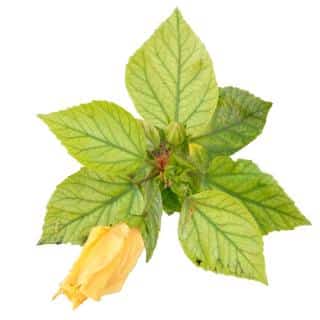

Chlorosis isn’t actually a disease. It is actually a physiological deficiency that plants endure when certain minerals or trace elements are found lacking in the soil. This occurs often when there is too much active lime.
An excess of limestone blocks plant roots from taking in certain elements such as iron.
Chlorosis symptoms are very typical:
Secondary symptoms differ depending on the type of chlorosis.
Some cases of chlorosis are caused not by lacking nutrients or minerals in the ground, but by diseases like fungus or bacterial infections. For instance, chlorosis is a symptom of a Xylella infection on olive.
All plants can experience chlorosis. Nonetheless, some are more vulnerable than others. This is clearly the case for plants that love acidic soil, such as Azalea, Hydrangea, Rhododendron, etc., as well as for “calcifuge” plants of which rose trees are a classic example. Soil type is important for these particularly picky plants. Whenever there is too much limestone in the soil, be sure to expect iron chlorosis.
If you can, it really helps to get a soil analysis done in your garden to prevent chlorosis. This will tell you if your soil contains too much limestone, or if basic trace elements are found lacking. The following elements and minerals are crucial for photosynthesis: magnesium, potassium, zinc, nitrogen, phosphorus, iron…
Many garden centers can help you test your soil. Check with the one nearest you how to go about it.
Iron chlorosis is the easiest deficiency to deal with. All you need to do is tweak your soil until the pH reaches 6.5 or lower (more acidic). In order to do so:

In this case, it’s even easier to manage. Since chlorosis is directly linked to soil quality, this disease usually simply signals that the time has come to change the potting soil for your plant.
But if you’ve repotted your plants recently, and still see no sign of them getting any better, just follow the same steps as for plants growing in the open air.
Another path to go is that of regularly applying fertilizer, preferably a fertilizer that contains high levels of trace elements.
Garden stores also sell products for adding during watering sessions. Look them up under the “anti-chlorosis product” label.
A famous old tip to fight against chlorosis, especially due to iron deficiency, is to bury rusty old metal items under the soil surface.